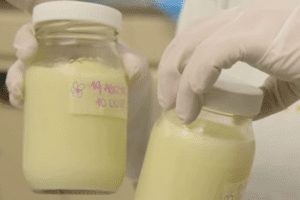
PFCs Found In Milk From Breast Milk. Those chemicals which have long been used to make cookware nonstick and fabrics stain-resistant are not only spreading around the world, but they are showing up in some surprising and disturbing places. Perfluorinated compounds, or PFCs, have shown up in wildlife, drinking water supplies, and human blood; however, a […]

PFCs Found In Milk From Breast Milk. Those chemicals which have long been used to make cookware nonstick and fabrics stain-resistant are not only spreading around the world, but they are showing up in some surprising and disturbing places. Perfluorinated compounds, or PFCs, have shown up in wildlife, drinking water supplies, and human blood; however, a team of researchers—including Kathleen Arcaro of the University of Massachusetts Amherst—found PFCs in samples of human milk from nursing mothers in Massachusetts. PFCs are believed to be carcinogenic.
“Perfluorinated compounds, or PFCs, are found in human blood around the world, including the blood of newborns, but this is the first study in the United States to document their occurrence in human milk,” says Arcaro, a professor in the department of veterinary and animal sciences and a member of the environmental sciences program. “While nursing does not expose infants to a dose that exceeds recommended limits, breast milk should be considered as an additional source of PFCs when determining a child’s total exposure.” The breast milk was collected as part of a larger, ongoing study Arcaro is conducting that is examining the link between environmental exposures and breast cancer.
PFCs are persistent chemicals that can linger in the environment and the human body for years without being broken down. PFCs can be found in food sources such as the grease-resistant packaging in microwave popcorn bags and pizza boxes. PFCs can also be found in fish and other animals and from personal care products including dental floss and shampoo.
Several studies have documented the presence of PFCs in the blood of newborns collected immediately after birth. Studies have also documented the presence of PFC in children between the ages of 2 and 12 and have revealed blood levels similar to those found in adults. It was these studies that led the team to investigate breast feeding as a source of PFCs. This information will be needed to determine the sources and breadth of exposure in infants and children and if PFCs have an effect on birth outcomes in newborns.
Chemical analyses were conducted in the laboratory of Kuruntachalam Kannan at the New York State Department of Health and results are scheduled for publication in Environmental Science and Technology. Research was supported by the Centers for Disease Control and Prevention (CDC) and the National Institute of Environmental Health Sciences.
Milk samples were collected in 2004 from 45 nursing mothers in Massachusetts. The breast milk was studied for nine different PFCs. The study revealed that perfluorooctane-sulfonate (PFOS), was found in the highest concentration in breast milk. PFOS is the chemical used to make stain-resistant fabrics. PFOS was followed by perfluorooctanoic acid (PFOA), which is used in nonstick cookware.
Milk from first-time nursing mothers was also studied to determine how PFC concentrations changed over time and it was discovered that total PFC concentrations and the concentration of PFOS increased during the first six months of nursing. “This may be related to increased food intake to meet the energy demands of nursing and changes in food consumption patterns in nursing mothers,” says Arcaro. “In a Canadian study, diet was shown to contribute 61 percent of a person’s total daily intake of PFCs.”
The personal injury attorneys at Parker Waichman LLP offer free, no-obligation case evaluations. For more information, fill out our online contact form or call 1-800-YOURLAWYER (1-800-968-7529).


